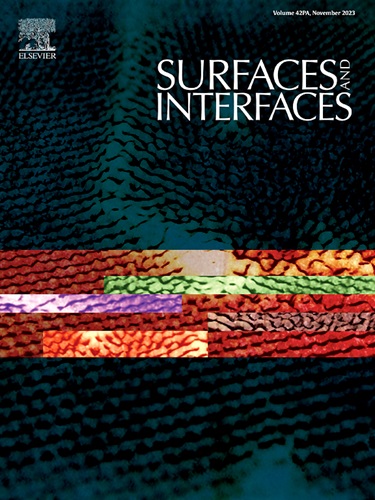合成工艺对表面活性还原氧化石墨烯(rGO)包裹SnS纳米球修饰电极形成的影响:CO传感行为的比较研究
IF 5.7
2区 材料科学
Q2 CHEMISTRY, PHYSICAL
引用次数: 0
摘要
基于过渡金属二硫族化合物的化学电阻器经常遇到挑战,例如在室温下性能不佳以及检测低气体浓度的灵敏度有限。在这项研究中,我们成功开发了一种低成本的一氧化碳(CO) OHP模式传感器电极,该电极使用还原氧化石墨烯rGO-SnS2纳米复合薄膜,在环境温度(29±2°C)下有效工作,并表现出强大的传感器响应。该传感器采用简单的物理和化学方法制备。我们利用x射线衍射(XRD)、场发射扫描电镜(FE-SEM)和高分辨率透射电镜(HR-TEM)等结构和表面形貌技术,利用OHP模式传感器电极表征了廉价传感器电极的结构和表面特征,其中包括原始rGO、SnS2及其纳米复合材料。利用x射线光电子能谱(XPS)系统地分析了沉积层的表面化学状态。通过I/V测量来评估这些化学电阻传感器的CO传感性能。纳米复合薄膜表明,传感器的反应速度快,恢复时间分别为11 s和10 s,最大响应率为90%,CO气体的检测限为2.91 ppm。,分别用于CO气体检测。本文章由计算机程序翻译,如有差异,请以英文原文为准。
Effect of synthesis technique on the formation of surface-active reduced graphene oxide (rGO) wrapped SnS₂ nanosphere modified electrode: A comparative study on CO sensing behaviours
Transition metal dichalcogenides based chemiresistors frequently encounter challenges, such as inadequate performance at room temperature and limited sensitivity for detecting low gas concentrations. In this study, we successfully developed a carbon monoxide (CO) low-cost OHP patterned sensor electrode using reduced graphene oxide rGO-SnS2 nanocomposite thin films that operate effectively at ambient temperature (29 ± 2 °C) and exhibit a robust sensor response. The sensor was fabricated using simple physical and chemical methods. We characterized the structural and surface characteristics of the inexpensive sensor electrode with an OHP pattern sensor electrode, which include pristine rGO, SnS2, and their nanocomposites, using structural and surface morphological techniques such as X-ray diffraction (XRD), field emission scanning electron microscopy (FE-SEM), and high-resolution transmission electron microscopy (HR-TEM) respectively. The surface chemical state of the deposited layer has been systematically analyzed through X-ray photoelectron spectroscopy (XPS). The CO sensing performance of these chemiresistive sensors was assessed using I/V measurements. The nanocomposite thin films demonstrated the sensor demonstrated quick reaction and recovery times of 11 and 10 s, respectively, with a maximum response of 90 % and a detection limit of 2.91 ppm for CO gas., respectively for CO gas detection.
求助全文
通过发布文献求助,成功后即可免费获取论文全文。
去求助
来源期刊

Surfaces and Interfaces
Chemistry-General Chemistry
CiteScore
8.50
自引率
6.50%
发文量
753
审稿时长
35 days
期刊介绍:
The aim of the journal is to provide a respectful outlet for ''sound science'' papers in all research areas on surfaces and interfaces. We define sound science papers as papers that describe new and well-executed research, but that do not necessarily provide brand new insights or are merely a description of research results.
Surfaces and Interfaces publishes research papers in all fields of surface science which may not always find the right home on first submission to our Elsevier sister journals (Applied Surface, Surface and Coatings Technology, Thin Solid Films)
 求助内容:
求助内容: 应助结果提醒方式:
应助结果提醒方式:


